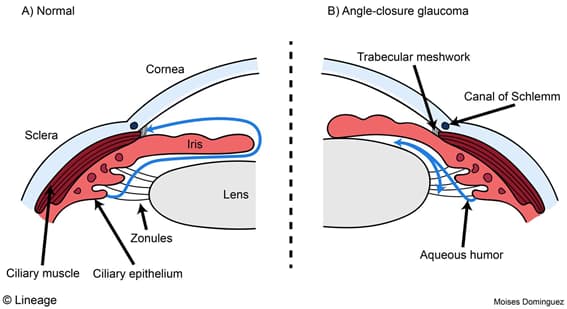Snapshot

- A 55-year-old male presents with severe light-sided pain around the eye. He experiences blurred vision and nausea. His symptoms began while at the movie theatre. On physical exam, decreased visual acuity is appreciated. Inspection of the eye is shown.
Introduction

- Optic neuropathy characterized by optic nerve damage and visual abnormalities
- majority of patients have increased intraocular pressure (IOP)
- important causative risk factor
- associated with increased resistance to aqueous outflow
- compresses retinal blood supply or retinal ganglion cells
- optic disc atrophy with cupping → visual loss
- majority of patients have increased intraocular pressure (IOP)
- Aqueous humor inflow and outflow maintains intraocular pressure
- ciliary body produces aqueous humor
- humor gets resorbed by the trabecular meshwork and uveoscleral outflow pathway
- Glaucoma can be characterized into
- open-angle or angle-closure
- Epidemiology
- second leading cause of blindness
- cataracts is first
- open-angle glaucoma is more common
- risk factor examples
- family history
- age
- second leading cause of blindness
- race
Open-Angle Glaucoma
- Open-angle glaucoma is most common among Europeans and African Americans
- Presentation
- usually asymptomatic
- Etiology
- primary open-angle glaucoma
- unclear
- secondary open-angle glaucoma
- neovascularization
- e.g., diabetes mellitus
- debri
- e.g., RBCs, WBCs, pseudoexfoliation
- corticosteroids
- retinal detachment
- neovascularization
- primary open-angle glaucoma
- Evaluation
- visual acuity
- visual field testing
- intraocular pressure
- pachymetry
- Treatment
- pharmacologic
- increases aqueous outflow
- prostaglandins (becoming first-line)
- α-agonists
- cholinomimetics
- decreases aqueous production
- carbonic anhydrase inhibitors
- α-agonists
- β-blockers
- increases aqueous outflow
- laser therapy
- trabeculoplasty
- surgical
- filtration bleb
- pharmacologic
- Prognosis, prevention, and complications
- prognosis
- does not substantially reverse
- prevention
- may involve lower IOP
- complications
- prognosis
- blindness
Angle-Closure Glaucoma
- Angle-closure glaucoma is more common in people of Asian decent
- Presentation
- symptoms
- very painful
- frontal headache
- ↓ vision (photophobia/blurry vision)
- halos around lights
- eye very firm
- physical symptoms
- fixed-dilated pupil
- corneal clouding
- conjunctival injection
- symptoms
- Etiology
- obstruction of flow between the iris and cornea
- can have primary (anatomy) or secondary (pulling or pushing the iris to shorten the angle) causes
- angle-closure crisis is an ophthalmic emergency
- can have primary (anatomy) or secondary (pulling or pushing the iris to shorten the angle) causes
- obstruction of flow between the iris and cornea
- Evaluation
- visual acuity
- visual field testing
- intraocular pressure
- evaluation of anterior chamber via slit-lamp
- gonioscopy (gold standard)
- Treatment
- iridotomy
- topical β-blockers, α2-agonists
- epinephrine contraindicated!
- α1-agonism causes mydriasis
- epinephrine contraindicated!
- oral carboanhydrase inhibitors
- Prognosis, prevention, and complications
- prognosis
- progressive vision loss that may lead to blindness
- if not detected early and not properly managed
- progressive vision loss that may lead to blindness
- prognosis



